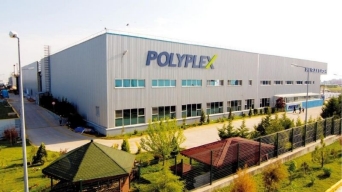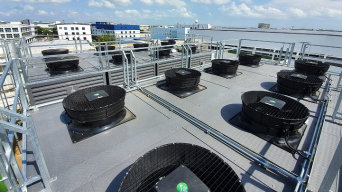FanGrid makes airport operators happy
AHU Retrofit, Singapore
©Changi Airport
After a retrofit, a FanGrid is in operation at Changi Airport in Singapore. This is good news, not only for the operators, but also the travelers.
Singapore is a city-state that is facing major challenges – especially when it comes to sustainability and environmental protection. This is why the government launched an initiative in 2005 which focused on the ecological evaluation of buildings. It is based on the Building and Construction Authority (BCA) Green Mark scheme, a leading assessment system for green construction in the tropics and subtropics. An ambitious goal was announced: 80 percent of the buildings in Singapore should drastically reduce their energy consumption by 2030.
“The BCA Green Mark scheme has ventured more industry players into green buildings by providing a standard benchmark for building owners to follow,” says Dina Bai, Marketing Manager at ebm‑papst South East Asia. Changi Airport Group is one of them. Changi Airport Group (CAG), a world-class service icon and the operator of Changi Airport Singapore – one of the world’s best airports, always puts sustainability as its focus.
By 2030, 80 percent of the buildings in Singapore should reduce their energy consumption. Changi Airport Terminals host tourists from all over the world. ©Changi Airport
Knowing that energy used to cool terminal buildings is its largest source of emissions, CAG decided to optimise its air-conditioning and mechanical ventilation (ACMV) systems. The goal was to make the ventilation systems more energy efficient without compromising the comfort and pleasant environment for all.
Improvement potential with air-conditioning
After having reviewed the current air-conditioning systems, CAG’s Mechanical and Electrical (M&E) Engineering team identified the potential area for improvement: The conventional belt-driven AC fans in Air Handling Units (AHUs) were inefficient and difficult to maintain.
As AHUs are key components of centralised air-conditioning that distribute cool air around the vast terminal buildings, CAG took the opportunity to leverage the leading technology from ebm‑papst to further improve energy efficiency and lower operational costs for its ventilation systems.
In Terminal 3, A total of 46 EC fans were installed. ©Changi Airport
EC technology adoption
Climate protection is a priority for ebm‑papst. “As a member of the Singapore Green Building Council, it is very important to us to make a contribution to a sustainable and greener future in Singapore,” explains Dina. “EC fans are a good choice in this regard.”
In consultation with CAG, ebm‑papst developed the concept for a FanGrid with EC fans. The FanGrid’s modular design provides not only the best energy efficiency but also the redundancy which ensures a high level of operational reliability. Furthermore, several small fans operating in parallel require less space and are lighter than a single large fan, reducing costs as a result.
A total of 46 EC fans were installed in seven AHUs in Changi Airport Terminal 3, ten of which were in the largest AHU to ensure sufficient airflow.
Air flow improved, lower maintenance
As measurements prove, the improved air flow has already resulted in significant savings: In addition to an average energy saving of 25 percent, air performance has increased by more than 15 percent. Although passenger numbers are noticeably lower during the pandemic, when the number of travelers rises again they will enjoy much more peace in the terminal. The FanGrid operates quietly and with minimal vibration.
Another advantage of the system is that the EC fans are very low-maintenance. As a result, everyone benefits from the new system: CAG building management, visitors to airport and the environment.
published on ebm‑papst magazine “mag”


